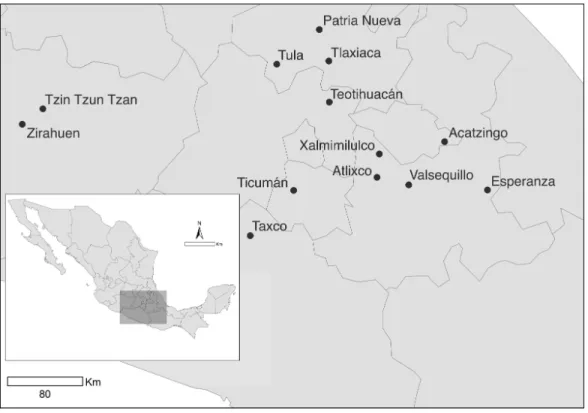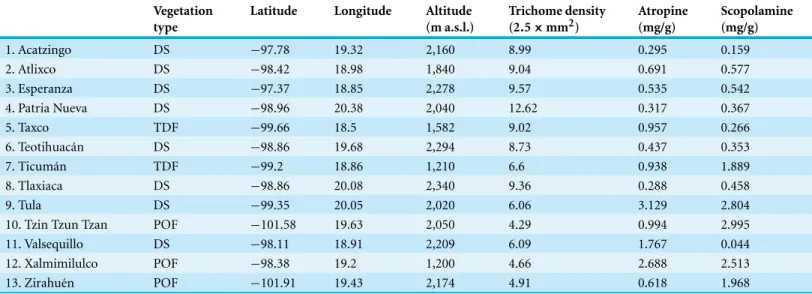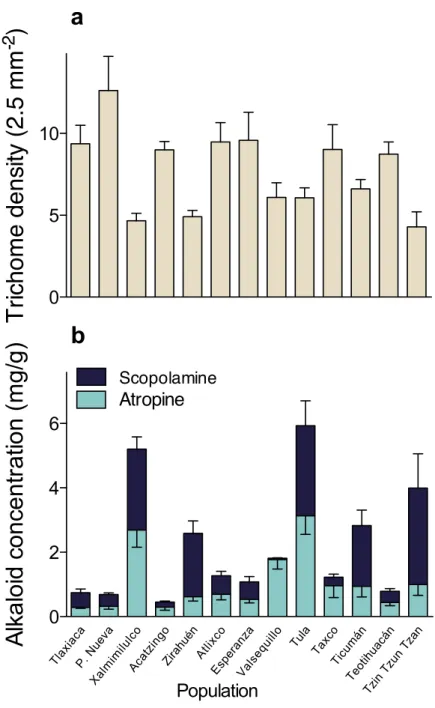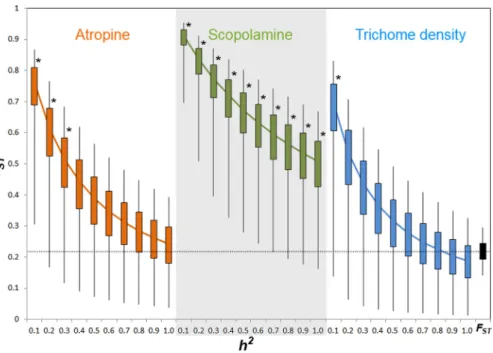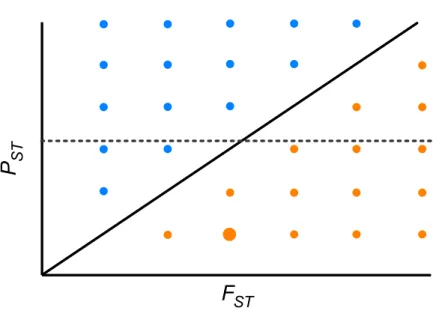Submitted 6 May 2015 Accepted 28 October 2015 Published26 November 2015
Corresponding author Juan N ´u˜nez-Farf´an, farfan@unam.mx
Academic editor Michael Singer
Additional Information and Declarations can be found on page 11
DOI10.7717/peerj.1411
Copyright 2015 Castillo et al.
Distributed under
Creative Commons CC-BY 4.0
OPEN ACCESS
Adaptive divergence in resistance to
herbivores in
Datura stramonium
Guillermo Castillo1, Pedro L. Valverde2, Laura L. Cruz1,
Johnattan Hern´andez-Cumplido3, Guadalupe Andraca-G ´omez1,
Juan Fornoni1, Edson Sandoval-Castellanos1, Erika Olmedo-Vicente1,
C´esar M. Flores-Ortiz4and Juan N ´u˜nez-Farf´an1
1Department of Evolutionary Ecology, Institute for Ecology UNAM, Mexico Distrito Federal,
Mexico
2Departamento de Biolog´ıa, Universidad Aut ´onoma Metropolitana-Iztapalapa, Mexico Distrito
Federal, Mexico
3Laboratory of Evolutionary Entomology, Institute of Biology, University of Neuchˆatel,
Neuchˆatel, Switzerland
4Facultad de Estudios Superiores Iztacala, UNAM, Estado de M´exico, Mexico
ABSTRACT
Defensive traits exhibited by plants vary widely across populations. Heritable phenotypic differentiation is likely to be produced by genetic drift and spatially restricted gene flow between populations. However, spatially variable selection exerted by herbivores may also give rise to differences among populations. To ex-plore to what extent these factors promote the among-population differentiation of plant resistance of 13 populations ofDatura stramonium, we compared the degree of phenotypic differentiation (PST) of leaf resistance traits (trichome density,
at-ropine and scopolamine concentration) against neutral genetic differentiation (FST)
at microsatellite loci. Results showed that phenotypic differentiation in defensive traits among-population is not consistent with divergence promoted by genetic drift and restricted gene flow alone. Phenotypic differentiation in scopolamine con-centration was significantly higher thanFSTacross the range of trait heritability
values. In contrast, genetic differentiation in trichome density was different fromFST
only when heritability was very low. On the other hand, differentiation in atropine concentration differed from the neutral expectation when heritability was less than or equal to 0.3. In addition, we did not find a significant correlation between pair-wise neutral genetic distances and distances of phenotypic resistance traits. Our findings reinforce previous evidence that divergent natural selection exerted by herbivores has promoted the among-population phenotypic differentiation of defensive traits in D. stramonium.
Subjects Ecology, Evolutionary Studies
Keywords Adaptive divergence, Tropane alkaloids, Leaf trichomes, Plant defense,PST–FST comparison,Datura stramonium, Divergent natural selection, Genetic drift and restricted gene flow, Plant resistance
INTRODUCTION
traits can be effectively produced by processes like genetic drift, mutation, founder effects or population isolation (Gomulkiewicz et al., 2007). However, phenotypic differentiation in traits that contribute to individuals’ fitness may also have a spatial structure caused by varying selective regimes exerted by biotic and/or abiotic factors (Holsinger & Weir, 2009). Furthermore, stabilizing selection may promote phenotypic similarity among populations (Meril¨a & Crnokrak, 2001). Elucidating to what extent these processes promote character differentiation among populations is central if we are to fully understand the prevalence of among-population variation in the wild (Lynch, 1990;Althoff& Thompson, 1999;
Criscione, Blouin & Sunnucks, 2006;Kelly, 2006;Gomulkiewicz et al., 2007). Here we aimed to determine if among-population variation in traits that confer resistance to herbivores in the annual plantDatura stramoniumis consistent with a scenario of varying selection or genetic drift and restricted gene flow.
To infer whether natural selection explains the observed differentiation among populations in putatively adaptive quantitative characters(QST), it is necessary to contrast
this hypothesis against a null model of differentiation at adaptively neutral loci (FST;Spitze, 1993;Martin, Chapuis & Goudet, 2008;Whitlock, 2008). The detection of a significant difference between the estimators of differentiation,QSTandFST, may imply adaptive
differentiation among populations. The comparison of the differentiation indices has three possible outcomes each with a unique interpretation (see Table 1 inMeril¨a & Crnokrak, 2001). WhenQSTandFSTare statistically equal, this implies that the degree
of differentiation in quantitative traits could be produced by drift alone. This does not necessarily imply that genetic drift produced the observed phenotypic differentiation but that the roles of selection and drift are indiscernible. WhenQST<FST, it means
that natural selection might be favoring the same phenotype across populations. Finally, whenQSTsignificantly exceedsFST, it means that directional selection is favoring different
phenotypes in different populations. WhenQSTandFSTare equal, it is expected that
both indices, estimated among pairs of populations of the same species, will be positively correlated, implying isolation by distance, restricted gene flow and genetic drift (although a partial role of selection could be involved also), or high recombination between molecular neutral marker loci and quantitative trait loci (Meril¨a & Crnokrak, 2001). In contrast, no correlation between both indices of differentiation among local populations may implicate a role of natural selection (see ‘Discussion’).
In order to explore the signals of non-neutral evolution in quantitative traits it is necessary to estimateQSTandFST.FSTis commonly estimated by analyzing variance in
allele frequency (Wright, 1951) at molecular markers, like microsatellite loci. On the other hand, to estimateQSTit is necessary to know the amount of additive genetic variance
of quantitative traits in many local populations (Spitze, 1993). However, accomplishing the latter objective is not feasible for a large number of populations because it requires estimating the breeding values of genotypes (families) for a suite of phenotypic characters in each local population.PST(degree of phenotypic differentiation index) is an analogous
index to QST(Leinonen et al., 2006;Leinonen et al., 2013), useful for exploring if
markers (Meril¨a & Crnokrak, 2001). The use ofPSTinstead ofQSTis justified when
estimates of additive genetic variance are not available (Leinonen et al., 2006;Leinonen et al., 2013;Lehtonen et al., 2009). Estimation of additive genetic variation in traits makes it necessary to obtain the phenotypic covariance between relatives (families) with an experimental common garden and/or the use of reciprocal transplant experiments to rule out the environmental effects on phenotypes. Hence,PSTcan be used as a surrogate ofQST.
Resistance traits exhibited by plants (i.e., traits that prevent/reduce damage by natural enemies) vary widely across populations (N´u˜nez-Farf´an, Fornoni & Valverde, 2007;Z¨ust et al., 2012). Selection exerted by herbivores is a major force driving the evolution of plants’ resistance traits (Rausher, 2001;Anderson & Mitchell-Olds, 2011;Z¨ust et al., 2012). Thus, among-population differentiation in resistance traits is likely to be produced by spatial variation in the local selective regimes exerted by herbivores. Such spatially variable selection can be generated by among-population variation in the abundance, species composition, feeding styles, and degree of dietary specialization of herbivores to their host plants (Falconer & Mackay, 1996;Charlesworth, Nordborg & Charlesworth, 1997;Parchman & Benkman, 2002;Arany et al., 2008;Hare, 2012).Datura stramonium(Solanaceae) provides an optimal system for studying among-population differentiation in resistance traits. Because of its wide distribution (Mexico, Canada, United States, and Europe), D. stramoniumis exposed to different environmental conditions and to a wide diversity of herbivore species (Weaver & Warwick, 1984;Valverde, Fornoni & N´u˜nez-Farf´an, 2001;
Cuevas-Arias, Vargas & Rodr´ıguez, 2008). Resistance against herbivores inD. stramonium includes leaf trichomes (Valverde, Fornoni & N´u˜nez-Farf´an, 2001;Kari˜nho-Betancourt & N´u˜nez-Farf´an, 2015) and tropane alkaloids (Shonle & Bergelson, 2000), of which atropine, hyosciamine and scopolamine are the most abundant (Parr et al., 1990;Kari˜nho-Betancourt et al., 2015). These secondary metabolites affect the activity of the neurotransmitter acetylcholine (Roddick, 1991) with negative effects on insects and vertebrate herbivores (Hsiao & Fraenkel, 1968;Krug & Proksch, 1993;Wink, 1993;Shonle, 1999;Mith¨ofer & Boland, 2012). Recent studies have found ample geographic variation in leaf trichome density and atropine and scopolamine concentration in central Mexico (Castillo et al., 2013;Castillo et al., 2014). However, it is unclear if selection by herbivores or neutral processes, among other factors, can account for the observed among-population differentiation in these resistance traits.
Here, we assessed to what extent population differentiation in resistance leaf traits (trichome density, atropine and scopolamine concentrations) ofD. stramonium is accounted by neutral processes (genetic drift and restricted gene flow) or divergent natural selection. To do so, we compared the degree of phenotypic differentiation of resistance traits by means ofPSTestimated for the whole range of values of heritability, with the
neutral expectation set by allelic divergence at microsatellite loci(FST). We expect thatPST
of each resistance character would be significantly higher than the index of population differentiation in neutral molecular markers(FST), since previous studies have detected
Figure 1 Sampled populations ofDatura stramoniumin central Mexico (seeTable 1).
METHODS
Study system
Datura stramoniumL. (Solanaceae) is an annual herb commonly found in roadsides, cultivated areas and disturbed environments in Mexico, the United States, Canada, and Europe (Valverde, Fornoni & N´u˜nez-Farf´an, 2001;Weaver, Dirks & Warwick, 1985;Van Kleunen, Markus & Steven, 2007). In Mexico, leaves ofD. stramoniumare consumed by a dietary specialist herbivore, the chrysomelidLema trilineata(Nu˜nez-Farfan & Dirzo, 1994), the dietary oligophagousEpitrix parvula(Chrysomelidae), which also feeds from other members of the Solanaceae family (Glass, 1940), and by the dietary generalist grasshopperSphenarium purpurascens(Nu˜nez-Farfan & Dirzo, 1994).Datura stramonium features leaf trichomes and tropane alkaloids (atropine and scopolamine) as resistance traits against herbivory. These traits have shown heritable basis (Shonle & Bergelson, 2000;
Valverde, Fornoni & N´u˜nez-Farf´an, 2001;Kari˜nho-Betancourt & N´u˜nez-Farf´an, 2015), and are under selection by dietary specialist and generalist herbivores (Castillo et al., 2014).
Fieldwork
Table 1 Vegetation type, latitude, longitude, altitude and population means of leaf trichome density, and atropine and scopolamine concentra-tions of 13 populaconcentra-tions ofDatura stramoniumin central Mexico.
Vegetation type
Latitude Longitude Altitude
(m a.s.l.)
Trichome density (2.5×mm2)
Atropine (mg/g)
Scopolamine (mg/g)
1. Acatzingo DS −97.78 19.32 2,160 8.99 0.295 0.159
2. Atlixco DS −98.42 18.98 1,840 9.04 0.691 0.577
3. Esperanza DS −97.37 18.85 2,278 9.57 0.535 0.542
4. Patria Nueva DS −98.96 20.38 2,040 12.62 0.317 0.367
5. Taxco TDF −99.66 18.5 1,582 9.02 0.957 0.266
6. Teotihuac´an DS −98.86 19.68 2,294 8.73 0.437 0.353
7. Ticum´an TDF −99.2 18.86 1,210 6.6 0.938 1.889
8. Tlaxiaca DS −98.86 20.08 2,340 9.36 0.288 0.458
9. Tula DS −99.35 20.05 2,020 6.06 3.129 2.804
10. Tzin Tzun Tzan POF −101.58 19.63 2,050 4.29 0.994 2.995
11. Valsequillo DS −98.11 18.91 2,209 6.09 1.767 0.044
12. Xalmimilulco POF −98.38 19.2 1,200 4.66 2.688 2.513
13. Zirahu´en POF −101.91 19.43 2,174 4.91 0.618 1.968
Notes.
DS, desert shrub; POF, Pine–Oak forest; TDF, tropical deciduous forest.
Resistance traits quantification
FollowingValverde, Fornoni & N´u˜nez-Farf´an (2001), we estimated leaf trichome density as the total number of trichomes in an observation field of 2.5 mm2located in the central basal region of the adaxial side of the leaf, using a stereoscopic microscope. Then we averaged the trichome density per plant from a random sample of 20 fully expanded leaves. We also quantified the concentration of atropine and scopolamine (two major alkaloids in D. stramonium) from a sample of 20 leaves per plant by means of High Precision Liquid Chromatography (HPLC). Details of the extraction method and HPLC conditions can be found elsewhere (seeCastillo et al., 2013).
Data analysis
We estimated the neutral genetic differentiation among populations ofD. stramonium usingFSTvalues obtained from five nuclear microsatellite markers designed specifically
forD. stramoniumas reported byAndraca-G´omez (2009).FSTvalues were calculated using
FSTAT 2.9.3.1 (Goudet, 2001) employing approximately 30 individuals per population. In addition, we assessed the statistical power of our five microsatellites by means of Wright–Fisher simulations as implemented in the program PowSim (Ryman & Palm, 2006). The program requires a divergence time and effective populations sizes so we tested a number of feasible combinations.
Phenotypic divergence in resistance traits
We used the degree of among-population phenotypic divergence(PST)to explore if
restricted gene flow and genetic drift(FST)alone can account for this differentiation or
(Leinonen et al., 2006;Pujol et al., 2008). We estimatedPSTas
PST=
σGB2
σGB2 +2(h2•σ2 GW)
,
whereσGB2 is the variance among populations,σGW2 is the variance within population, and h2is the trait heritability (Leinonen et al., 2006). Since this is not feasible for a large number of populations we used an approximation byPST.
In order to obtainPSTvalues for resistance traits, we simulated the whole range of
heritabilities (0≤h2 ≤1). To estimatePSTvalues we fitted a linear model for each
resistance trait, under the assumption that the distribution of resistance traits was normally distributed. Thepopulationterm was considered as a random effect. To test the hypothesis thatPSTis higher thanFST, a Monte Carlo test was carried out, approaching a sample
of 10,000 deviates from bothPSTandFSTby means of their estimated error.PSTerror
was estimated from the likelihood errors of its components (variances among- and within-populations), whileFSTerror was obtained by bootstrapping (Goudet, 2001).
The 10,000 random deviates ofFSTandPSTwere compared and thep-value was obtained
as the proportion of comparisons in which theFSTwas equal or higher than thePST(null
hypothesis).
We further evaluated the pair-wise Pearson’s correlation betweenFSTandPSTfor
all populations. Neutral marker variation can be used as a neutral expectation against which the phenotypic divergence of traits can be compared (Gomulkiewicz et al., 2007). If resistance phenotypic differentiation between populations(PST)is the result of neutral
processes rather than selection, differentiation among populations in these traits should correlate positively with differentiation in selectively neutral markers(FST)(Meril¨a & Crnokrak, 2001;Gomulkiewicz et al., 2007;Lehtonen et al., 2009;Leinonen et al., 2013). We evaluated the pair-wise correlation between theFSTandPSTfor different scenarios of
heritability (h2=0.1, 0.25, 0.5, 0.75 and 1.0). Statistical analyses were performed using JMP®version 9.0.0 (SAS Institute, Cary, NC, 1989–2007).
RESULTS
Among-population variation in resistance traits
A multivariate analysis of variance (MANOVA) detected significant multivariate differences in the studied resistance traits of 13 populations ofD. stramonium(Wilks’
λ=0.091,F36,331.64 =11.51,P<0.0001). After the subsequent univariate ANOVAs
were applied, we found significant differences in trichome density (F12,126 =5.10,
P<0.0001), atropine (F12,126=7.85,P<0.0001), and scopolamine concentration
(F12,126=23.33,P<0.0001). Mean leaf trichome density and mean atropine and
scopolamine concentration per population are shown inFig. 2andTable 1.
Genetic differentiation between populations ofD. stramonium
Genetic differentiation as estimated by differences in allele frequency at microsatellite loci was moderate.FSTwas 0.228 (S.E.=0.039), which is well above the minimum detectable
Figure 2 Among-populations variation in leaf trichome density (A), and atropine and scopolamine concentration (B) in 13 populations ofDatura stramoniumin central Mexico.Bars represent average
value+1 SE.
Phenotypic divergence in resistance traits
Comparison of phenotypic (PST)and neutral genetic marker divergence (FST)showed
thatPSTvalues for scopolamine concentration were significantly higher than theFSTin all
values ofh2(Fig. 3). However,PSTfor atropine concentration was significantly higher than
FSTwhen 0≥h2≤0.3 (Fig. 2), whereasPSTof leaf trichome density significantly exceeded
Figure 3 PSTvalues of putative defensive traits ofDatura stramoniumas a function of their genetic
variance (h2) among populations.Confidence intervals of 50% and 95% are indicated by bars and lines,
respectively. * Represents overallPSTvalues that differ significantly fromFST(the black bar at the right end) after a Monte Carlo test (10,000 deviates from bothPSTandFST; see ‘Methods’).
Table 2 Correlation (r) between pair-wisePSTof three resistance traits and pair-wiseFSTfor all
populations ofDatura stramonium, under different scenarios of heritability (h2=0.1, 0.25, 0.5, 0.75 and 1.0).
Resistance trait r
h2=0.1 h2=0.25 h2=0.5 h2=0.75 h2=1.0
Atropine −0.0644 −0.0671 −0.0655 −0.0642 −0.0637
Scopolamine 0.0264 0.0344 0.0348 0.0316 0.0278
Trichome density −0.135 −0.1218 −0.1053 −0.0939 −0.0855
Pair-wise correlation betweenFST andPST
We found no significant correlations between pair-wiseFST andPSTvalues among
populations for any of the three resistance characters (Table 2). Most correlation values were small (i.e.,−0.135≤r≤0.034).
DISCUSSION
Results showed that phenotypic differentiation in resistance traits among population of D. stramoniumis not consistent with divergence promoted by genetic drift and restricted gene flow alone (Pujol et al., 2008;Lehtonen et al., 2009). Phenotypic differentiation in scopolamine concentration was significantly higher thanFSTacross the range ofh2.
In contrast, genetic differentiation in trichome density was different fromFSTonly
differentiation in atropine concentration seems to differ from the neutral expectation only at low values ofh2. Furthermore, we did not find a correlation between pair-wise neutral genetic distances and phenotypic distances of any of the three resistance traits. Taken together, results suggest that natural selection could be involved in phenotypic divergence on resistance traits among populations ofD. stramonium.
Results indicate that populations ofD. stramoniumare differentiated in both pheno-typic and neutral molecular markers. We found a moderate amount of differentiation among populations at microsatellite loci (FST=0.228). Using thisFSTvalue, the indirect
estimate of gene flow (Nm) is 0.846, suggesting restricted gene flow among populations ofD. stramonium, and not sufficient to prevent differentiation by genetic drift (Hedrick, 2000). This contrasts with differentiation at neutral loci reported for other organisms whereFSTis generally lower than 0.228 (but seeMeril¨a & Crnokrak, 2001). PSTindex
values statistically not different from this value ofFSTimply that quantitative phenotypic
characters follow a pattern of drift-induced divergence (Leinonen et al., 2006). Here, we found that thePSTindex of scopolamine was significantly higher thanFSTfor all
values of heritability considered (cf.Fig. 3). This result strongly suggests that phenotypic differentiation among populations in scopolamine concentration is congruent with a scenario of divergent selection exerted by herbivores among populations. However,PST
of atropine and leaf trichome density was higher thanFSTonly when heritability was ≤0.3 and≤0.1, respectively. This implies that the proportion of genetic variance among populations from total genetic variance is high for these characters (Lehtonen et al., 2009;
Leinonen et al., 2013). When genetic variance within populations is low, as implied by low values of heritability, there is a high opportunity to detect a significantPSTgiven
that the among-population genetic variance component has a relevant weight in the total phenotypic variance. Inversely, when heritability is high, the within-population genetic component accounts for a high fraction of total genetic variance renderingPSTvery small.
These considerations may explain whyPSTof trichome density and atropine are different
fromFSTonly at very low heritability.
AlthoughPSTis used as an analog ofQST(genetic differentiation in quantitative
char-acters) when it is not possible to obtain the amount of additive genetic variation (variance among families, within populations) (Meril¨a & Crnokrak, 2001), conclusions derived from these estimations must be interpreted with caution since this index can be biased by all environmental variation due to abiotic conditions among localities as well as environ-mental deviations within populations, and non-additive genetic variation (v.gr., epistatic interactions, dominance, linkage disequilibrium), among others (Pujol et al., 2008). Thus is relevant to ask whetherPSTindex obtained for the resistance traits inD. stramonium
defenses). In addition, broad-senseh2of general resistance and trichome density has been estimated in 0.25 and 0.64, respectively (Kari˜nho-Betancourt & N´u˜nez-Farf´an, 2015). Also, genetic variance in trichome density among-populations (Valverde, Fornoni & N´u˜nez-Farf´an, 2001) and general resistance (Valverde, Fornoni & N´u˜nez-Farf´an, 2003;Carmona & Fornoni, 2013) has been detected inD. stramonium. Finally, genetic variance in alkaloid concentration (hyosciamine and scopolamine, and their ratio) has been detected previ-ously byShonle & Bergelson (2000). Thus, there is ample evidence of genetic basis of pheno-typic variation in resistance ofD. stramoniumto support our estimation ofPSTvalues.
Because aPSTindex higher thanFSTmeans that divergent selection might be involved in
population differentiation of resistance traits, at least for scopolamine, it is relevant to ask to what extent natural selection by herbivores is responsible for population differentiation in this character. InD. stramonium, several lines of evidence strongly suggest that differentiation in resistance is accounted by for herbivores. Differential and contrasting selection gradients on resistance to herbivores were detected between two populations of this species in a reciprocal transplant experiment (Fornoni, Valverde & N´u˜nez-Farf´an, 2004). Likewise,Shonle & Bergelson (2000)detected stabilizing selection on hyosciamine and directional selection to reduce scopolamine concentration inD. stramonium. In a recent study of eight populations ofD. stramonium,Castillo et al. (2014)found that atropine is selected against by the dietary specialist herbivoresEpitrix parvula(in one population) andLema daturaphila(in two populations). In contrast, scopolamine was positively selected in one population where the specialistLema daturaphilawas the main herbivore, whereas trichome density was positively selected in two populations (one with L. daturaphilaand one with the generalist grasshopperSphenarium puprurascens), and negatively selected in one population with theE. parvula(Castillo et al., 2014). Thus, although genetic drift and restricted gene flow could produce phenotypic variation in plant resistance among populations, the available evidence of spatially variable selection on resistance traits inD. stramoniumand data presented here suggests that population differentiation can be potentially adaptive.
Furthermore, we did not detect any significant correlation between the pair-wise PST andFST among population across the whole range of heritability, suggesting
that differentiation at quantitative traits and neutral molecular loci is decoupled. Theoretically, if the pace of differentiation is dictated by genetic drift only, it is expected that differentiation indices will be perfectly and positively correlated (r=1,PST=FST;
Fig. 4). If the correlation is positive but lower than 1, then genetic drift has a role but does not explain all differentiation in quantitative traits. In the region above the diagonal in Fig. 4, wherePST>FST, any positive pair-wise correlation across populations, depicts
a scenario where differentiation in quantitative traits exceeds the neutral expectation and suggests divergent selection (Fig. 4). On the other hand, in the region below the diagonal, wherePST<FST, any positive pair-wise correlation across populations, portrays
a scenario where differentiation at neutral molecular loci surpasses that of quantitative characters suggesting a strong effect of genetic drift; however at moderate values ofFST
Figure 4 Theoretical relationship between pair-wisePSTand pair-wiseFSTacross populations of a
species.The solid diagonal line indicates a perfect and positive correlation between both indices (r=1, PST=FST). Above the diagonal, blue points are pairs of populations wherePST>FST. Below the diagonal, orange points are pairs of populations wherePST<FST. Dotted line indicates one possible scenario where both indices are uncorrelated. At moderate values ofFST stabilizing selection might be promoting low phenotypic differentiation between a given pair of populations (big orange point).
scenario, as found here. This implies that genetic drift and restricted gene flow alone cannot explain (Pujol et al., 2008) the pattern of differentiation among populations in resistance traits inD. stramonium. Under this scenario there is opportunity for divergence driven by selection in resistance traits. Our results suggest that the higherPSTthanFST
for scopolamine, together with spatial variation in resistance traits and the existence of a selection mosaic detected previously byCastillo et al. (2014)are consistent with outcomes predicted by the geographic mosaic of coevolution (Thompson, 2005).
ACKNOWLEDGEMENTS
We thank very much to Professor Michael Singer for his valuable revision to our manuscript. We thank to Blanca Hern´andez, Martha Mac´ıas Rubalcava, Mar´ıa Teresa Caudillo, Luis Barbo and Martha Urz ´ua Meza for helping us during HPLC quantification, and to Rosalinda Tapia-L ´opez and the members of Laboratorio de Gen´etica Ecol ´ogica y Evoluci ´on for their logistical support and field assistance. Thanks are also extended to the Laboratorio de Alelopat´ıa of Instituto de Ecolog´ıa, UNAM for providing the facilities for laboratory work. This paper constitutes a partial fulfillment of the Graduate Program in Biological Sciences of the National Autonomous University of Mexico (UNAM).
ADDITIONAL INFORMATION AND DECLARATIONS
Funding
GC acknowledges the National Council of Science and Technology (CONACyT) for a scholarship and financial support. The funders had no role in study design, data collection and analysis, decision to publish, or preparation of the manuscript.
Grant Disclosures
The following grant information was disclosed by the authors: CONACyT grant: 255600.
Evoluci ´on adaptativa de la defensa en Datura: Resistencia y Tolerancia a los herb´ıvoros. PAPIIT-UNAM: IN-212214.
Competing Interests
The authors declare there are no competing interests.
Author Contributions
• Guillermo Castillo conceived and designed the experiments, performed the experi-ments, analyzed the data, wrote the paper, prepared figures and/or tables, reviewed drafts of the paper.
• Pedro L. Valverde analyzed the data, wrote the paper, reviewed drafts of the paper.
• Laura L. Cruz, Guadalupe Andraca-G ´omez and Juan Fornoni performed the
experi-ments.
• Johnattan Hern´andez-Cumplido performed the experiments, reviewed drafts of the paper.
• Edson Sandoval-Castellanos analyzed the data, wrote the paper, prepared figures and/or tables, reviewed drafts of the paper.
• Erika Olmedo-Vicente analyzed the data.
• C´esar M. Flores-Ortiz performed the experiments, contributed
reagents/materials/analysis tools.
• Juan N ´u˜nez-Farf´an conceived and designed the experiments, analyzed the data, contributed reagents/materials/analysis tools, wrote the paper, reviewed drafts of the paper.
Data Availability
The following information was supplied regarding data availability: The research in this article did not generate any raw data.
Supplemental Information
Supplemental information for this article can be found online athttp://dx.doi.org/ 10.7717/peerj.1411#supplemental-information.
REFERENCES
AlthoffDM, Thompson JN. 1999.Comparative geographic structures of two Parasitoid-Host
Anderson JT, Mitchell-Olds T. 2011.Ecological genetics and genomics of plant defences: evidence and approaches.Functional Ecology25:312–324DOI 10.1111/j.1365-2435.2010.01785.x.
Andraca-G ´omez G. 2009.Gen´etica de poblaciones comparada entreDatura stramoniumy su
herb´ıvoro especialistaLema trilineata. MSc dissertation, Universidad Nacional Aut ´onoma de M´exico (UNAM), Mexico City.
Arany A, De Jong T, Kim H, Van Dam N, Choi Y, Verpoorte R, Van der Meijden E. 2008. Glucosinolates and other metabolites in the leaves ofArabidopsis thalianafrom natural populations and their effects on a generalist and a specialist herbivore.Chemoecology18:65–71
DOI 10.1007/s00049-007-0394-8.
Carmona D, Fornoni J. 2013.Herbivores can select for mixed defensive strategies in plants.New Phytologist197:576–585DOI 10.1111/nph.12023.
Castillo G, Cruz LL, Hern´andez-Cumplido J, Oyama K, Flores-Ortiz CM, Fornoni J, Valverde PL, N ´u˜nez-Farf´an J. 2013.Geographic association and temporal variation of defensive traits and leaf damage inDatura stramonium.Ecological Research28:663–672
DOI 10.1007/s11284-013-1059-4.
Castillo G, Cruz LL, Tapia-L ´opez R, Olmedo-Vicente E, Carmona D, Anaya-Lang AL, Fornoni J, Andraca-G ´omez G, Valverde PL, N ´u˜nez-Farf´an J. 2014.Selection mosaic exerted by specialist and generalist herbivores on chemical and physical defense ofDatura stramonium.PLoS ONE 9:e102478DOI 10.1371/journal.pone.0102478.
Charlesworth B, Nordborg M, Charlesworth D. 1997.The effects of local selection, balanced polymorphism and background selection on equilibrium patterns of genetic diversity in subdivided populations.Genetical Research70:155–174DOI 10.1017/S0016672397002954.
Criscione CD, Blouin MS, Sunnucks P. 2006.Minimal selfing, few clones, and no amog-host
genetic structure in a hermaphroditic parasite with asexual propagation.Evolution60:553–562
DOI 10.1111/j.0014-3820.2006.tb01136.x.
Cuevas-Arias CT, Vargas O, Rodr´ıguez A. 2008.Solanaceae diversity in the state of Jalisco, Mexico. Revista Mexicana de Biodiversidad79:67–79.
Falconer DS, Mackay T. 1996.Introduction to quantitative genetics. 4th edition. Harlow: Addison-Wesley Longman.
Fornoni J, Valverde PL, N ´u˜nez-Farf´an J. 2003.Quantitative genetics of plant tolerance and resistance against natural enemies of two natural populations ofDatura stramonium. Evolutionary Ecology Research5:1049–1065.
Fornoni J, Valverde PL, N ´u˜nez-Farf´an J. 2004.Population variation in the cost and benefit of tolerance and resistance against herbivory inDatura stramonium.Evolution58:1696–1704
DOI 10.1111/j.0014-3820.2004.tb00455.x.
Glass EH. 1940.Host plants of the tobacco flea beetle.Journal of Economic Entomology33:467–470
DOI 10.1093/jee/33.3.467.
Gomulkiewicz R, Drown DM, Dybdahl MF, Godsoe W, Nuismer SL, Pepin KM, Ridenhour BJ,
Smith CI, Yoder JB. 2007.Dos and don’ts of testing the geographic mosaic theory of
coevolution.Heredity98:249–258DOI 10.1038/sj.hdy.6800949.
Goudet J. 2001.FSTAT, a program to estimate and test gene diversities and fixation indices. version 2.9.31. Lausanne: Institut d’Ecologie, Batiment de Biologie, Universite de Lausanne.Available athttp://www2.unil.ch/popgen/softwares/fstat.htm.
Hare JD. 2012. How Insect herbivores drive the evolution of plants.Science338:50–51
Hedrick PW. 2000.Genetics of populations. 2nd edition. Sudbury: Jonesand Bartlett Publishers. Holsinger KE, Weir BS. 2009.Genetics in geographically structured populations: defining,
estimating and interpretingFST.Nature Reviews Genetics10:639–650DOI 10.1038/nrg2611. Hsiao TH, Fraenkel G. 1968.The role of secondary plant substances in the food specificity
of the Colorado potato beetle.Annals of the Entomological Society of America61:485–503
DOI 10.1093/aesa/61.2.485.
Kari˜nho-Betancourt E, Agrawal AA, Halitschke R, N ´u˜nez-Farf´an J. 2015. Phylogenetic
correlations among chemical and physical plant defenses change with ontogeny.New Phytologist 206:796–806DOI 10.1111/nph.13300.
Kari˜nho-Betancourt E, N ´u˜nez-Farf´an J. 2015.Evolution of resistance and tolerance to herbivores: testing the trade-offhypothesis.PeerJ3:e789DOI 10.7717/peerj.789.
Kelly JK. 2006.Geographical variation in selection, from phenotypes to molecules.The American Naturalist167:481–495DOI 10.1086/501167.
Krug E, Proksch P. 1993.Influence of dietary alkaloids on survival and growth ofSpodoptera littoralis.Biochemical and Systematic Ecology21:749–756DOI 10.1016/0305-1978(93)90087-8. Lehtonen PK, Laaksonen T, Artemyev AV, Belskii E, Both C, Bureˇs S, Bushuev AV, Krams I,
Moreno J, M¨agi M. 2009. Geographic patterns of genetic differentiation and plumage colour variation are different in the pied flycatcher (Ficedula hypoleuca).Molecular Ecology 18:4463–4476DOI 10.1111/j.1365-294X.2009.04364.x.
Leinonen T, Cano J, M¨akinen H, Meril¨a J. 2006.Contrasting patterns of body shape and neutral genetic divergence in marine and lake populations of threespine sticklebacks.Journal of Evolutionary Biology19:1803–1812DOI 10.1111/j.1420-9101.2006.01182.x.
Leinonen T, McCairns RS, O’Hara RB, Meril¨a J. 2013.QST–FST comparisons: evolutionary and ecological insights from genomic heterogeneity.Nature Reviews Genetics14:179–190
DOI 10.1038/nrg3395.
Lynch M. 1990.The rate of morphological evolution in mammals from the standpoint of the
neutral expectation.The American Naturalist136:727–741DOI 10.1086/285128.
Martin G, Chapuis E, Goudet J. 2008.MultivariateQST—FST comparisons: a neutrality test for the evolution of the G matrix in structured populations.Genetics180:2135–2149
DOI 10.1534/genetics.107.080820.
Meril¨a J, Crnokrak P. 2001.Comparison of genetic differentiation at marker loci and quantitative traits.Journal of Evolutionary Biology14:892–903DOI 10.1046/j.1420-9101.2001.00348.x. Mith¨ofer A, Boland W. 2012.Plant defense against herbivores: chemical aspects.Annual Review of
Plant Biology63:431–450DOI 10.1146/annurev-arplant-042110-103854.
Nu˜nez-Farfan J, Dirzo R. 1994.Evolutionary ecology ofDatura stramoniumL. in central Mexico: natural selection for resistance to herbivorous insects.Evolution48:423–436
DOI 10.2307/2410102.
N ´u˜nez-Farf´an J, Fornoni J, Valverde PL. 2007.The evolution of resistance and tolerance to herbivores. Annual Review of Ecology, Evolution, and Systematics 38:541–566
DOI 10.1146/annurev.ecolsys.38.091206.095822.
Parchman TL, Benkman CW. 2002.Diversifying coevolution between crossbills and black spruce
on Newfoundland.Evolution56:1663–1672DOI 10.1111/j.0014-3820.2002.tb01478.x. Parr A, Payne J, Eagles J, Chapman B, Robins R, Rhodes M. 1990.Variation in tropane alkaloid
Pujol B, Wilson AJ, Ross RIC, Pannell JR. 2008.AreQST–FSTcomparisons for natural popula-tions meaningful?Molecular Ecology17:4782–4785DOI 10.1111/j.1365-294X.2008.03958.x.
Rausher MD. 2001.Co-evolution and plant resistance to natural enemies.Nature411:857–864
DOI 10.1038/35081193.
Rice K, Jain S. 1985.Plant population genetics and evolution in disturbed environments. In: Pickett STA, White PS, eds.The ecology of natural disturbance and patch dynamics. New York: Academic Press, 287–303.
Roddick J. 1991.The importance of the solanaceae in medicine and drug therapy. In: Hawkes JG,
Lester RN, Nee M, Estrada N, eds.Solanaceae. III. Taxonomy, chemistry, evolution. Kew: Royal Botanic Garden Press, 7–23.
Ryman N, Palm S. 2006.POWSIM: a computer program for assessing statistical power when
testing for genetic differentiation.Molecular Ecology Notes6:600–602
DOI 10.1111/j.1471-8286.2006.01378.x.
Shonle I. 1999.Evolutionary ecology of tropane alkaloids. PhD dissertation, University of Chicago, Chicago, IL.
Shonle I, Bergelson J. 2000.Evolutionary ecology of the tropane alkaloids ofDatura stramonium L. (Solanaceae).Evolution54:778–788DOI 10.1111/j.0014-3820.2000.tb00079.x.
Spitze K. 1993.Population structure in Daphnia obtusa: quantitative genetic and allozymatic variation.Genetics135:367–374.
Thompson J. 2005.The geographic mosaic of coevolution. Chicago: University of Chicago Press. Valverde PL, Fornoni J, N ´u˜nez-Farf´an J. 2001.Defensive role of leaf trichomes in resistance
to herbivorous insects inDatura stramonium.Journal of Evolutionary Biology14:424–432
DOI 10.1046/j.1420-9101.2001.00295.x.
Valverde PL, Fornoni J, N ´u˜nez-Farf´an J. 2003.Evolutionary ecology ofDatura stramonium: equal plant fitness benefits of growth and resistance against herbivory.Journal of Evolutionary Biology 16:127–137DOI 10.1046/j.1420-9101.2003.00482.x.
Van Kleunen M, Markus F, Steven DJ. 2007.Reproductive assurance through self-fertilization
does not vary with population size in the alien invasive plantDatura stramonium.Oikos 116:1400–1412DOI 10.1111/j.0030-1299.2007.16004.x.
Weaver SE, Dirks V, Warwick S. 1985.Variation and climatic adaptation in northern populations
ofDatura stramonium.Canadian Journal of Botany63:1303–1308DOI 10.1139/b85-181.
Weaver SE, Warwick SI. 1984.The biology of Canadian weeds: 64.Datura stramoniumL.
Canadian Journal of Plant Science64:979–991DOI 10.4141/cjps84-132.
Whitlock MC. 2008. Evolutionary inference fromQST.Molecular Ecology 17:1885–1896
DOI 10.1111/j.1365-294X.2008.03712.x.
Wink M. 1993.Allelochemical properties or the raison d’etre of alkaloids. In: Cordell GA, ed.The alkaloids, vol. 43. New York: Academic Press, 1–118.
Wright S. 1951. The genetical structure of populations.Annals of Eugenics15:323–354
DOI 10.1111/j.1469-1809.1949.tb02451.x.
Z¨ust T, Heichinger C, Grossniklaus U, Harrington R, Kliebenstein DJ, Turnbull LA. 2012. Natural enemies drive geographic variation in plant defenses.Science338:116–119
